 |
 |
 |
| |
PEGASYS But Not Adefovir Results in Significant Decline in HBsAg in Chinese Patients with HBeAg-Positive Disease Harboring Lamivudine-Resistant YMDD Mutations
|
| |
| |
Reported by Jules Levin
Presented at the 19th Conference of the Asia Pacific Association for the Study of the Liver, 13-16 February 2009, Hong Kong, China
Hou, J,1 Sun, J,1 Xie, Q,2 Li, X,3 Zhang, J,4 Wang, Y,5 Wang, H,6 Lai, JY,7 Chen, S,8 Jia, J,9 Sheng, J-F,10 Chan, HL-Y,11 Wang, J,12 Li, M,13 Jiang, M,14 Popescu, M,15 Sung, JJY11
1 Nanfang Hospital, Guangzhou, China. 2Ruijin Hospital, Shanghai, China. 3You'an Hospital, Beijing, China. 4Huashan Hospital, Shanghai, China. 5Xi'nan Hospital, Chongqing, China. 6People's Hospital, Beijing, China. 7Princess
Margaret Hospital, Hong Kong, China. 8Infectious Disease Hospital, Shandong, China. 9Friendship Hospital, Beijing, China; 10The First Affiliated College of Medicine, Zhejiang University, Zhejiang, China; 11Prince of Wales
Hospital, Hong Kong, China; 12Public Health Clinical Center Affiliate to Fudan University, Shanghai, China; 13Tuen Mun Hospital, Hong Kong, China. 14Roche, Shanghai, China. 15Hoffmann-La Roche, Basel, Switzerland
Author Summary
The results from this interim analysis demonstrate that PEGASYS therapy has advantages over adefovir in management of hard-to-treat lamivudine-resistant patients
Although adefovir achieved significantly greater mean declines in HBV DNA level during treatment than PEGASYS, a similar number of patients in both treatment groups achieved suppression of the virus to below 400 copies/mL at week 48
PEGASYS therapy was associated with higher rates of HBeAg clearance and HBeAg seroconversion than adefovir at week 48
The HBsAg decline from baseline to week 48 was significantly greater in PEGASYS-treated patients than in adefovir-treated patients
In contrast to adefovir therapy PEGASYS achieved HBsAg clearance in a number of patients and, in particular, in a high proportion of patients who had achieved HBeAg seroconversion
Author Conclusions
Patients who have developed resistance to lamivudine are a notoriously hard-to-treat group. The results from this interim analysis provide encouraging results for use of PEGASYS in these patients. The high levels of HBeAg seroconversion and HBsAg clearance suggest that PEGASYS may have a role in the management of Chinese patients with YMDD mutations. Importantly, a number of patients treated with PEGASYS achieved HBsAg clearance, which is the closest we can achieve to clinical cure of CHB
Background
Nucleos(t)ide analogs have been shown to suppress HBV replication extremely effectively. However, in order to maintain the low levels of virus and prevent disease progression, these agents often need to be administered for long periods of time
Such long-term therapy is associated with development of resistance, which results in reappearance of the disease. It has been reported that 70% of patients treated with lamivudine for 4 years will develop resistance to the antiviral agent.1-3 Although some of the newer antiviral agents have lower rates of resistance development than lamivudine, resistance can still develop. Studies have shown that the rate of resistance in adefovir-treated patients is 28% after 5 years4 and in telbivudine-treated patients is 11% after 2 years5
Management of patients with nucleos(t)ide analog resistance can be challenging as cross resistance can develop between individual nucleos(t)ide analogs. In lamivudine-resistant patients treated with entecavir, 39.5% will develop resistance to entecavir after 3 years6,7
Lamivudine-resistant (YMDD) patients who have been unsuccessfully treated for a long time represent a hard-to-treat population
With its dual mechanism of action, PEGASYS provides an alternative treatment regimen for lamivudine-resistant patients and data from pilot studies have suggested that a finite course of PEGASYS therapy could be effective in achieving sustained antiviral efficacy in lamivudine-resistant patients8,9
A recent study showed that virologic response to PEGASYS in HBeAg-positive or HBeAg-negative patients who have failed patients10
Objective
To compare the efficacy and safety of PEGASYS with that of adefovir in a randomized study of HBeAg-positive patients with lamivudine-resistant (YMDD) chronic hepatitis B (CHB)
Methods
Patients from 13 centers across China were included in this randomized, open-label study comparing PEGASYS with adefovir in patients with lamivudine-resistant CHB
Patients with documented lamivudine-resistant (YMDD) CHB were randomized 2:1 to receive PEGASYS (180 μg/week) for 48 weeks or adefovir (10 mg/day) for 72 weeks. PEGASYS-treated patients were followed up for an additional 24 weeks after the end of the treatment period. All patients continued lamivudine treatment (100 mg/day) for the first 12 weeks of the study (Figure 1)
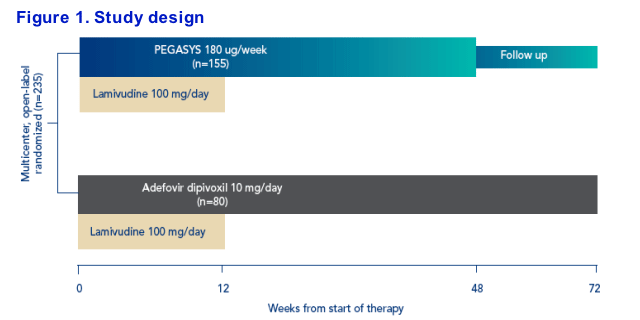
HBsAg levels were quantified at baseline and at weeks 24 and 48 using the Architect HBsAg assay (Abbott Diagnostics)
Efficacy endpoints included:
· HBeAg seroconversion
· HBeAg clearance
· HBsAg clearance
· HBV DNA suppression to <400 copies/mL
The data presented here are from a planned interim efficacy analysis at week 48
Results
Baseline demographics
Of the 251 patients with documented lamivudine-resistant CHB randomized to therapy, 235 received either PEGASYS (n=155) or adefovir (n=80) for the agreed duration - 48 weeks and 72 weeks, respectively
All patients reaching the 48-week time point were included in the interim analysis (per protocol)
The baseline characteristics were similar in both treatment groups (Table 1)
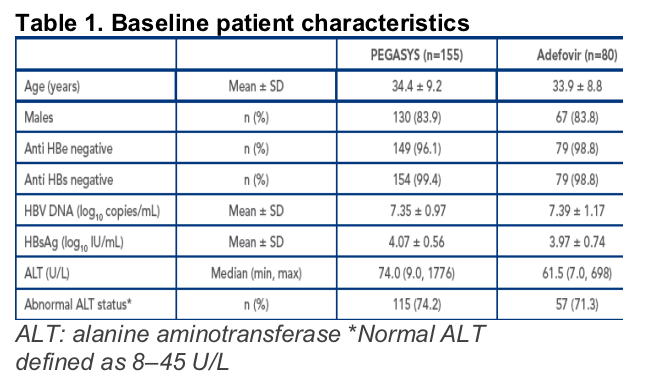
HBsAg response in lamivudine-resistant patients
Baseline HBsAg levels were similar in both treatment groups (Table 1). The decrease in HBsAg level from baseline to week 48 was significantly higher in the PEGASYS group than in the adefovir group (-0.92 log10 IU/mL and -0.35 log10 IU/mL, respectively, P<0.001) (Figure 2)
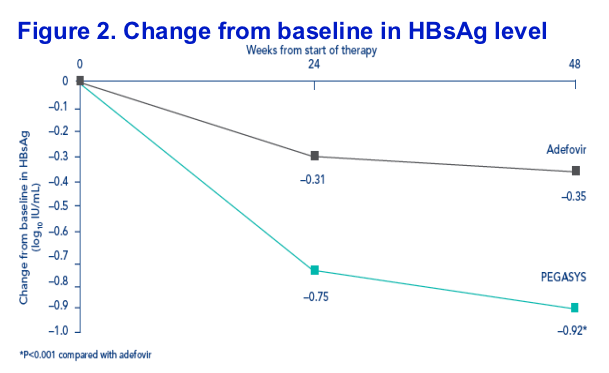
Six PEGASYS-treated patients (4%) achieved HBsAg clearance at week 48. None of the patients in the adefovir group achieved HBsAg clearance (P=0.098)
One patient in the PEGASYS group achieved HBsAg seroconversion at week 48. None of the patients in the adefovir group achieved HBsAg seroconversion
HBV DNA response in lamivudine-resistant patients
The decline in HBV DNA levels from baseline to week 48 was significantly greater in adefovir-treated patients than in PEGASYS-treated patients (P<0.001) (Figure 3).
Interestingly, a similar proportion of patients in both treatment groups achieved HBV DNA levels below 400 copies/mL at week 48 (28.4% for PEGASYS and 28.8% for adefovir, P=NS)
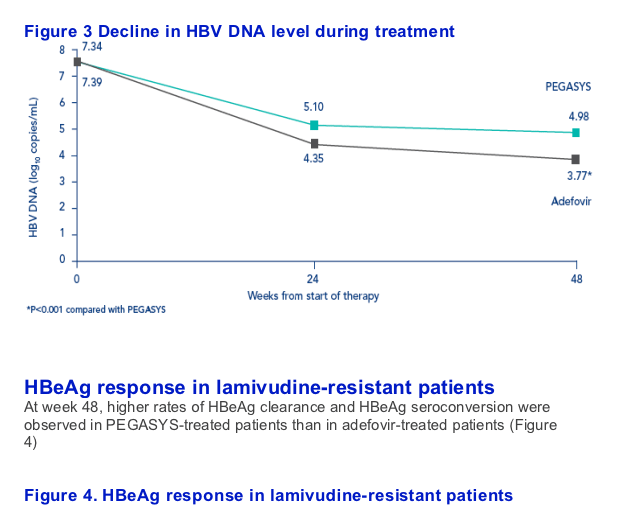
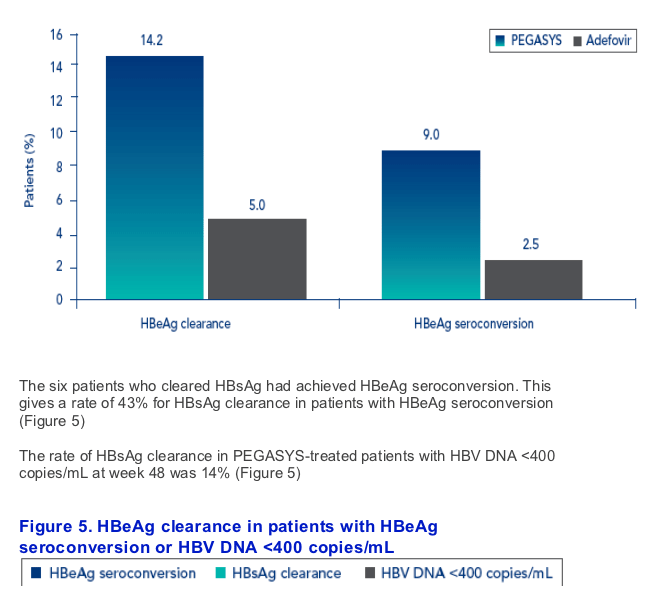
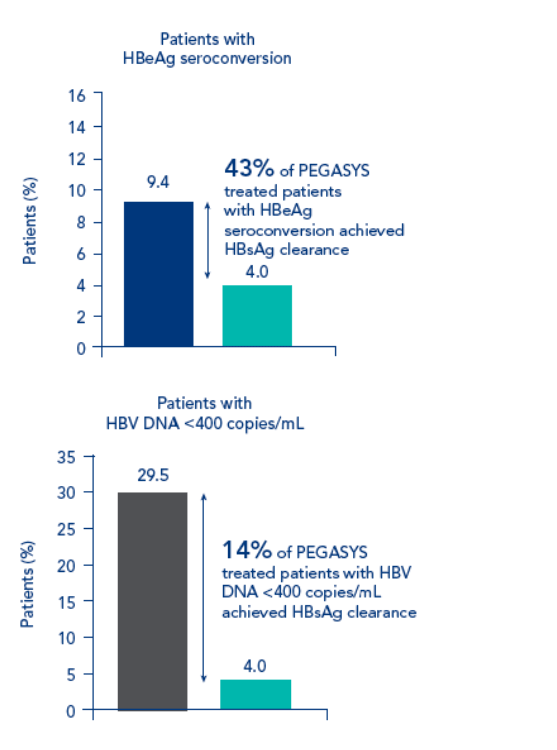
References
1. Liaw YF. The current management of HBV drug resistance. J Clin Virol 2 1. 005;34 (suppl 1):S143-6
2. Liaw YF. Impact of YMDD mutations during lamivudine therapy in patients with chronic hepatitis B. Antivir Chem Chemother 2001; 21 (suppl 1):67-71
3. Kwon SY et al. Rapid re-emergence of YMDD mutation of hepatitis B virus with hepatic decompensation after lamivudine retreatment. World J Gastroenterol 2008;14:4416-4419
4. Tillmann HL. Antiviral therapy and resistance with hepatitis B virus infection. World J Gastroenterol 2007;13:125-140
5. Liaw YF et al. 2-year GLOBE trial results: telbivudine is superior to lamivudine in patients with chronic hepatitis B. Gastroenterol 2008; Nov 1 (Epub ahead of print)
6. Tenney DJ et al. Two-year assessment of entecavir resistance in lamivudine-refractory hepatitis B virus patients reveals different clinical outcomes depending on the resistance substitutions present. Antimicrob Agents, Chemother 2007;51:902-911
7. Colonno RJ et al. Assessment at three years shows high barrier to resistance is maintained in entecavir-treated nucleoside naive patients while resistance emergence increases over time in lamivudine refractory patients. Hepatology 2006;44 (suppl 1):229A-230A
8. Shi XF et al. Peginterferon alfa-2a for patients with HBeAg-positive CHB who failed prior lamivudine treatment. Hepatol Int 2007; 1 (0-90):18
9. Xu D-Z et al. Efficacy and safety of peginterferon alfa-2a in Chinese patients with HBeAg-positive chronic hepatitis B. J Hepatol 2008; 48 (suppl 2):S266
10. Chan HL et al. Treatment of patients with chronic hepatitis B who have failed previous antiviral treatment with pegylated interferon alpha 2a (40 kda; PEGASYS). Antiviral Therapy 2008;13(4):555-562
|
| |
|
 |
 |
|
|